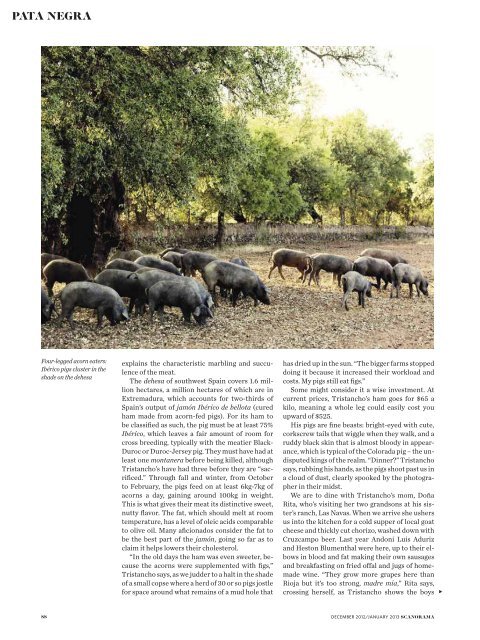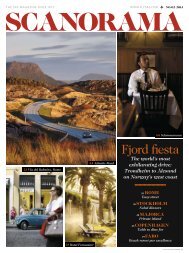Create successful ePaper yourself
Turn your PDF publications into a flip-book with our unique Google optimized e-Paper software.
PATA NEGRA<br />
Four-legged acorn eaters:<br />
Ibérico pigs cluster in the<br />
shade on the dehesa<br />
explains the characteristic marbling and succulence<br />
of the meat.<br />
The dehesa of southwest Spain covers 1.6 million<br />
hectares, a million hectares of which are in<br />
Ex tremadura, which accounts for two-thirds of<br />
Spain’s output of jamón Ibérico de bellota (cured<br />
ham made from acorn-fed pigs). For its ham to<br />
be classified as such, the pig must be at least 75%<br />
Ibérico, which leaves a fair amount of room for<br />
cross breeding, typically with the meatier Black-<br />
Duroc or Duroc-Jersey pig. They must have had at<br />
least one montanera before being killed, although<br />
Tristancho’s have had three before they are “sac -<br />
rificed.” Through fall and winter, from October<br />
to February, the pigs feed on at least 6kg-7kg of<br />
acorns a day, gain ing around 100kg in weight.<br />
This is what gives their meat its distinctive sweet,<br />
nutty flavor. The fat, which should melt at room<br />
temperature, has a level of oleic acids comparable<br />
to olive oil. Many aficionados consider the fat to<br />
be the best part of the jamón, going so far as to<br />
claim it helps lowers their cholesterol.<br />
“In the old days the ham was even sweeter, because<br />
the acorns were supplemented with figs,”<br />
Tristancho says, as we judder to a halt in the shade<br />
of a small copse where a herd of 30 or so pigs jostle<br />
for space around what remains of a mud hole that<br />
has dried up in the sun. “The bigger farms stopped<br />
doing it because it increased their workload and<br />
costs. My pigs still eat figs.”<br />
Some might consider it a wise in vestment. At<br />
cur rent prices, Tristancho’s ham goes for $65 a<br />
kilo, meaning a whole leg could easily cost you<br />
upward of $525.<br />
His pigs are fine beasts: bright-eyed with cute,<br />
corkscrew tails that wiggle when they walk, and a<br />
ruddy black skin that is almost bloody in appearance,<br />
which is typical of the Colorada pig – the undisputed<br />
kings of the realm. “Dinner?” Tristancho<br />
says, rubbing his hands, as the pigs shoot past us in<br />
a cloud of dust, clearly spooked by the photographer<br />
in their midst.<br />
We are to dine with Tristancho’s mom, Doña<br />
Rita, who’s visiting her two grandsons at his sister’s<br />
ranch, Las Navas. When we arrive she ushers<br />
us into the kitchen for a cold supper of local goat<br />
cheese and thickly cut chorizo, washed down with<br />
Cruz campo beer. Last year Andoni Luis Aduriz<br />
and Heston Blumenthal were here, up to their elbows<br />
in blood and fat making their own sausages<br />
and breakfasting on fried offal and jugs of homemade<br />
wine. “They grow more grapes here than<br />
Rioja but it’s too strong, madre mia,” Rita says,<br />
crossing herself, as Tristancho shows the boys<br />
88 DECEMBER 2012/JANUARY 2013 SCANORAMA<br />
�












